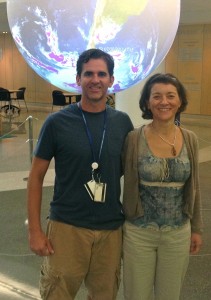
Month: July 2013
Flamig awarded 2013 Chateaubriand Fellowship
NSSL’s Zachary Flamig has been awarded the prestigious 2013 Chateaubriand Fellowship. The merit-based grant is offered by the Embassy of France in the United States and aims to encourage collaborations, partnerships or joint projects between France and the U.S. Flamig is a Ph.D. student in the School of Meteorology at The University of Oklahoma and works at NSSL with advisor J.J. Gourley.
Flamig will conduct his fellowship at the University Joseph Fourier in Grenoble, France and will work with the Hydrometeorology, Climate and Impacts (HCMI) team at the Laboratoire d’etude des Transferts en hydrologie et Environnement (LTHE). His mission will be to explore a variety of hydrologic models with various physics representations, including the French Cevennes (CVN) distributed hydrologic model, to determine the surface runoff generation and routing mechanisms that are needed to yield accurate simulations of flash floods. Results from his research topic will be incorporated in the U.S. Flooded Locations and Simulated Hydrographs (FLASH) project at NSSL, which capitalizes on the high-resolution (1km/5min) radar-based inputs from the NMQ/Q2 system. The four-month fellowship begins in January, 2014.
NSSL collaborated with the French team during HyMeX (Fall 2012) and used the NOAA X-Pol mobile radar to complement the research radar network. NSSL/CIMMS previously hosted an LTHE graduate intern, Martin Calianno, and is presently hosting Prof. Celine Lutoff, a social scientist. Flamig’s fellowship will strengthen collaboration between the teams to advance the state-of-the-science of flash flood prediction and societal impacts.
The 2013 Flash Flood and Intense Rainfall experiment (FFaIR)
A team from NSSL will partner with the NOAA Hydrometeorological Testbed at the Weather Prediction Center to host the 1st annual Flash Flood and Intense Rainfall Experiment (FFaIR). FFaIR will explore using high-resolution atmospheric and hydrologic models to improve short-term forecasts of both precipitation amounts and flash flooding. The project runs from July 8-26, 2013.
NSSL’s Flooded Locations And Simulated Hydrographs (FLASH) system will be one of several modeling systems evaluated during FFaIR. The FLASH system uses radar-estimated rainfall from NSSL’s National Mosaic and QPE System (NMQ/Q2) as input into the CREST (Coupled Routing and Excess STorage) hydrologic model. FLASH then creates real-time 6-hour forecasts on a 1km grid that is updated every 15 minutes.
The 2013 FFaIR experiment will provide, for the first time, a pseudo-real time environment where participants from across the weather enterprise can explore the interface of meteorology and hydrology. Working together through the forecast process will foster collaboration between National Centers for Environmental Prediction, National Weather Service Forecast Offices, NOAA labs, and the academic community.
